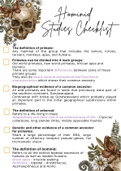Hominid
Studies Checklist
The definition of primate:
Any mammal of the group that includes the lemurs, lorises,
tarsiers, monkeys, apes, and humans.
Primates can be divided into 4 main groups:
Old world primates, new world primates, African apes and
Humans.
There are some important differences between some of these
primate groups.
They also do share several anatomical and functional
characteristics which shows their common ancestry
Biogeographical evidence of a common ancestor:
All wild primates are found in lands that previously were part of
the southern continent, Gondwanaland.
Continental drift broke up Gondwanaland which probably played
an important part in the initial geographical subdivisions within
primates.
The definition of arboreal:
Refers to a life living in trees.
Adaptations and their role in an arboreal way of life - Clavicle/
collarbone, long slender limbs, mobile opposable thumbs.
Genetic and other evidence of a common ancestor
for primates:
Share a large percentage of their DNA, large
number of olfactory receptor pseudo-genes, full
trichromatic vision.
The definition of hominid:
Refers to all the extinct bipedal ancestors of
humans as well as modem humans.
Great apes - knuckle walking
Hominins - bipedal - Ardipithecus,
Australopithecus and Homo
, Hominid
Studies Checklist
Anatomical similarities needed to be classified as a primate:
Brain, eyes, nose, teeth (dentition), shoulders and hands.
Anatomical differences to support the theory that that humans
evolved and became more advanced than African apes :
Brain, brow ridge, spine and limbs, pelvic girdle, palate shape and
canines, jaw, cranial ridge, foramen magnum.
Key features which palaentologists look at in fossils to have a
good outline of the evolutionary history of Homo sapiens
Bipedalism, brain size, teeth (dentition), prognathism, palate
shape, cranial ridges and brow ridges.
Quadrupedalism:
Definition - the ability of an organism to walk on all fours.
Bipedalism:
Definition - the ability of an organism to walk upright.
Advantages - smaller surface area to sun, larger surface area to
air currents, free hands, extended vision, ability to occupy a
wider range of habitats.
Observed changes in skeleton for bipedalism in quadrupedals
and bipedals
Foramen magnum, spine/vertebral column, limbs and digits,
pelvic girdle.
Observed changes in skeleton not related to
bipedalism in quadrupedals and bipedals
Skull and brain size, teeth (dentition),
prognathism and palate shape.
Genetic evidence:
Chromosomal - DNA found in the nucleus
Mitochondrial - DNA found in the
mitochondria




